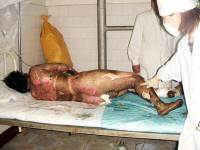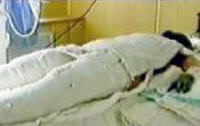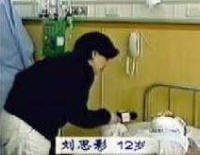54 Facts That Reveal How the "Self-Immolation" on Tiananmen Square Was Actually Staged for Propaganda Purposes - Part 3
This article was first published in October 2011.
(Minghui.org)
21. Burn Victim Covered in Gauze, Reporter Wears No Protective Clothing
Standard medical procedure dictates that patients with large areas of burned skin be placed in an isolated, sterile room, because the burned area needs to be exposed to the air. This prevents infection and makes it easier for the nurse to apply medication and clean the wounds. Doctors and nurses treating these patients are required to wear masks and sterile clothing when entering the room.
Yet, when we look at the CCTV footage, we see that the patient is in an open room. We also see that the patient is wrapped in thick layers of gauze bandages and that the nurse is not wearing a mask. Neither is the reporter wearing a mask, gloves, or any sterile clothing. Why would a patient in such critical condition with such serious burns be treated so casually?
Normal treatment for a burn victim: Doctors and nurses wear protective clothing and masks, and the burn victim is exposed to the air in a sterile environment to avoid infection.
CCTV's report, "Tiananmen Square Self-immolation Incident," shows the burn victim fully wrapped in gauze. The reporter wears no protective clothing or mask, and is shown interviewing the victim without any concern for spreading infection.
22. Ambulance Took Two Hours to Make a Twenty-Minute Trip
According a January 30, 2001 report of the Xinhua News Agency, at 2:41 p.m. on January 23, 2001, on the northeastern side of the People’s Hero Monument, Wang Jindong was the first to set himself on fire: “Less than a minute later, several policemen used four fire extinguishers and rapidly extinguished the fire on this man. They then used a police vehicle that was on duty to rapidly transport him to the hospital for emergency care.” According to this report, several minutes later, on the north side of the People’s Hero Monument, four women who were positioned not too far apart lit gasoline that they had poured on themselves. It only took a minute and half for the police to put out the flames. “Less than seven minutes after the incident took place, three ambulances from the Beijing Emergency Medical Center arrived at the scene and transported the people who were injured to the best burn unit in Beijing, the Jishuitan Hospital, for emergency treatment.” According to the Xinhua News Agency, the self-immolation incident took place at 2:41 p.m.. Adding the seven minutes it took to put out the fire and the twenty plus minutes that it normally takes for a vehicle to go from Tiananmen Square to the Jishuitan Hospital (it should take less time for an ambulance to make the journey), the participants in the self-immolation should have arrived at the Jishuitan Hospital no later than 3:30 p.m. Yet several medical personnel at the Jishuitan Hospital have confirmed that those who committed the self-immolation didn’t arrive at the hospital until around 5:00 p.m.. Between approximately 3:00 p.m. to 5:00 p.m., two hours elapsed. Reports from the Xinhua News Agency couldn’t explain where those people went during this period of time. What really happened during this period of time? Why did it take the ambulance two hours to complete a normal twenty-minute drive?
23. "Stationary" Survellence Camera is Directed to Capture the Event
From the CCTV program, one can see that the camera follows the police to the site where the fire began and even zooms in and out to catch just the right details of the drama as it unfolds. Normally, the surveillance camera in Tiananmen Square covers a fixed area. But on this particular day, the camera follows the police to the scene and zooms in to focus on the incident. It seems as if this camera was set up specifically to tape the self-immolation.
24. Large Amount of Video Covers the Incident
The public was shown many views of the self-immolation, taken from multiple angles, far shots, medium shots, and close shots, even photographs. If it wasn’t prearranged, then how could it have been captured so completely?
Even more unnatural is that fact that when 12-year-old burn victim Liu Siying’s life is in danger, we can see that someone takes a close-up shot of her and records her voice. We can only wonder: What are the priorities here? – saving a young child at all possible costs, or collecting evidence for future use?
25. "Self-Immolator" Quotes Not Falun Gong
1) Liu Siying was reported by Chinese media to have said that her own mother told her to set herself on fire to reach "The Heavenly Golden Kingdom" in some reports, and "Nirvana" in other reports. Yet, these terms are not part of Falun Gong.
2) Another "self-immolator" appeared frequently on TV claiming to be a Falun Gong practitioner. She said that she saw others starting the fire first, producing black smoke. Yet she felt that when "de" (virtue) is burned it should produce white smoke, since "de" is a white substance. Only when burning "karma" should it produce black smoke.
No sentence in Falun Dafa states that burning "de" will generate white smoke; nor that burning "karma" will generate black smoke. The terms relate to morality, and have never been associated with combustion!
26. News of the Self-Immolation Broadcast Immediately
Within two hours of the incident, Xinhua immediately made an announcment blaming Falun Gong practitioners for the self-immolation. Immediately following the announcement, the Focus Interview program of CCTV, broadcasted a commentary program and made authorative-sounding conclusions, again accusing Falun Gong. This was in stark contrast to the way news is usually handled in China, where lower-level officials report to their superiors and so on until the top officials allow the news to be published. Manuscripts of sensitive news stories to be aired on the Xinhua News Agency must be reviewed and drafted many times. In this instance the story was out to the public with such unheard of speed that it roused people’s suspicions.
"In terms of response time, another foreign journalist in Beijing expressed shock that Xinhua was able to release the first report on the incident almost immediately and in English, no less. Every Chinese citizen knows that every report from Xinhua usually has to first go through several rounds of approval by higher-ups and is generally 'old news' by the time it is published. Moreover, state-run media have never released any photos or video of Falun Gong protests in the course of 18 months of persecution to the foreign press, so why now and with so little hesitation? And why only in English and not in Chinese? ...."
"The Wall Street Journal's Ian Johnson, one of the most insightful journalists following this story, had his suspicions aroused by the speed with which this story was covered, observing that the state media "reported [the victim's] death with unusual alacrity, implying that either the death took place earlier than reported or the usually cautious media had top-level approval to rush out electronic reports and a televised dispatch. The 7 p.m. local evening news, for example, had a filmed report from Mr. Tan's hometown of Changde, a small city in Hunan province. Most reports for the evening news are vetted by noon, so the daily broadcast rarely carries reports from the same day, let alone an event that happened at noon and involved satellite feeds from relatively remote parts of the country."
The Fires This Time: Immolation of Deception in Bejing? By Danny Schechter
Although the government controlled media aired the story within two hours, it is worth noting that it took over a week to complete video production of the event.
27. Chinese Reports Contradict - Part 1
According to a study by the WOIPFG, five seperate Chinese reports released over a period of a year give completely different accounts as to how and when Wang Jindong and his family began to practice Falun Gong. Some definitively state that he had practiced for more than one year, while others give earlier dates, one as far back as 1996. Click here for the report.
28. Chinese Reports Contradict - Part 2
In "Wang Jindong's Personal Statement on the January 23 Self-Immolation Incident," published by Xinhua on April 7, 2003, Wang Jindong recalled,
"At about 2:30 p.m.… I flicked on the lighter and I was instantly engulfed by flames. I did not have time to sit in the [double-leg crossing] so I sat in the single crossing leg posture. Driven by the large flames, the air was making loud noises. I could hardly breathe, but I was very clear that the goal will soon be realized. At that moment, police tried to stop the fire by covering me with something unknown. I twice refused to let them put out the fires on my body. A few moments later, someone used fire extinguishers and the fire was put out. I was very disappointed, stood up and called out, 'Truth, Compassion and Forbearance [Zhen, Shan and Ren] is the universal law. It is the law which everyone must follow. My Master is the chief Buddha.'"
At this point in the article, Wang Jindong said that he "stood up and called out." More specifically, he said that he stood up and called out the words after the fire was put out.
An earlier Xinhua report published on January 30, 2001, stated, "Afterwards, red flames burst out from the man, forming a dark smoke. Amongst the red flames, the man shouted desperately: 'The great law of the universe is the law that everyone must experience.'"
The two reports contradict in their descriptions of the fire and the words Wang calls out. Additionally, both reports contradict with CCTV's video footage, in which:
-
No fire or smoke is seen on Wang, (see Fact #8)
-
Wang is sitting on the ground when he calls out,
-
Wang does not call out what he said in his "Personal Statement," (of which the last two sentences are not representative of Falun Gong)
-
Wang is not even doing the single-leg posture.
29. Chinese Reports Contradict - Part 3
In "Wang Jindong's Personal Statement...," Wang said that the group poured the petrol into drink bottles, and then:
"Liu Yunfang and I hung the bottles on our necks and secured the bottles under our armpits with sticky tape, then we put on our wool jumpers, followed by cotton-padded (quilted) jackets. After that, we took with us the single-edged blades and lighters which Hao Huijun had purchased in advance."
"At about 2:30 pm, I used the blade I had prepared in my hand to cut through the clothes and sliced the bottle, and then I threw away the blade and took out the lighter. At that moment, the police were walking towards me, and when they were at about ten paces from me, I flicked on the lighter and I was instantly engulfed by flames".
According to Wang's own account, the petrol on his body came from a bottle hung around his neck and attached under his armpit by sticky tape. The bottle was sliced open and the petrol flowed over his body.
However, according to the January 30 Xinhua article:
"At 2:41 p.m., north-east of People's Heroes Memorial Monument, a man in his forties, facing north-west, sat in a 'leg-crossing' posture, and continuously poured liquid over his body from a green plastic bottle. Afterwards, red flames burst out from the man's body, exuding a pall of dark smoke...."
The article clearly states that Wang Jindong had "continuously poured liquid over his body from a green plastic bottle." Both articles give lengthy descriptions on how the so-called self-immolators managed to pour petrol over themselves. Both refer to the fact that the group had test-run the procedure several times. That is to say, it was very important to the self-immolators how the petrol would be poured onto themselves. Yet the two reports are entirely at odds with each other over this very crucial technical issue (using blades to cut open the bottle vs. pouring).
30. Chinese Reports Contradict - Part 4
In "Wang Jingdong's Personal Statement...," Wang said that after the self-immolation, the police vehicle drove at a very high speed towards Jishuitan Hospital. "At the hospital, I was lying on a bed in an emergency consultation room...."
A Beijing Evening News article dated February 16, 2001, states: "Xiao Yang, who is able to sprint 100 meters in 13 seconds, and his team-mates carried Wang Jindong, whose hair had been completely burnt, onto the police vehicle, drove quickly to the Xuanwu District City Emergency Center at lightning speed. Later he was transferred from the emergency centre to Jishuitan Hospital."
-
The articles give different locations to where the police vehicle went (Jishuitan Hospital and Xuanwu Emergancy Center)
-
The CCTV footage shows Wang's hair is not "completely burnt" (see Fact #5)
-
Had the police vehicle been driving "at a very high speed," "quickly," or "at lightning speed" (as both articles are consistant on this point), it would not have taken two hours to get to the hospital (see Fact #22)


